Sometimes it's easier to follow an unfamiliar recipe if you can see it done. Regardless of the scrapple recipe you choose to follow, the actual steps are pretty much the same.
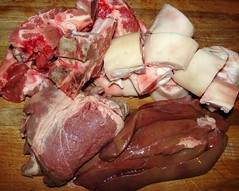
Start with a few pounds of pork. I like a more traditional style scrapple, so for this batch I'll be using pork neck bones, pig's feet, pork heart, and pork liver. "Variety meats" like these are relatively inexpensive and a bit of "livery" flavor makes the scrapple taste better. If you prefer you can use other cuts - I often make scrapple with fresh hocks, for example - but try not to make them too lean. Like sausage, scrapple needs some fat to be at it's best.
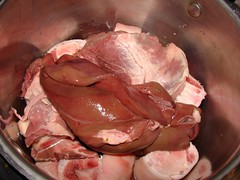 Put the meats into a pressure cooker - bony bits at the bottom on the cooker's rack, and softer stuff (heart and liver) on top. Add 6 cups of water, seal the pressure cooker, and put it over medium heat.
Put the meats into a pressure cooker - bony bits at the bottom on the cooker's rack, and softer stuff (heart and liver) on top. Add 6 cups of water, seal the pressure cooker, and put it over medium heat.When the jiggler on top starts dancing, start timing. For feet, neck bones, hocks, and tough muscles like the heart, I cook the meat under pressure for 45 minutes to 1 hour to make sure all the cartilage, skin, and tendons are rendered soft. If you're using a better cut of pork you can cut the cooking time appropriately. When the cooking time is over, turn off the heat under the pan and allow the pressure to fall naturally for an hour or so. Open the pressure cooker and discard the bones, but save any skin, fat, cartilage, tendons, etc. You might also find that the amount of liquid in the pan has been reduced by about half, leaving a rich pork broth. Strain the broth and add water sufficient to make 4 cups of liquid.

Place the cooked pork into a food processor with a cup or so of the broth and pulse it until it turns into a smooth puree. (If you don't have a food processor, you can use a meat grinder - fit it with the finest plate. You might have to run the meat through twice.)
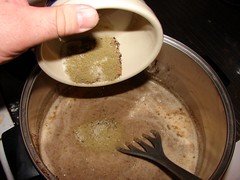
Transfer the puree to a heavy stockpot or Dutch oven over medium heat and stir in the broth. It will be kind of soupy looking. As the mixture starts to bubble, stir in your seasonings.
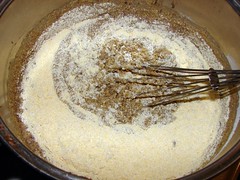
As the mixture simmers, add your cornmeal slowly, one cup at a time, stirring with a whisk as you make the additions to prevent it from forming lumps. At this point, if the mixture is too stiff you might want to drizzle in some water to loosen it up.
 With all the cornmeal stirred in, cook slowly over medium low heat as the scrapple thickens. As the cornmeal cooks, the mixture will get progressively harder to stir. Take small tastes every now and then to be sure your seasonings are right and adjust them accordingly. As you taste, feel the texture of the cornmeal in your mouth. At first, the scrapple will feel "grainy" because the cornmeal is still uncooked and hard. As the it cooks, though, the texture will become softer and smoother. If the scrapple seems to be getting too thick without getting smooth, add a small amount of water and continue to cook, tasting again after a couple of minutes.
With all the cornmeal stirred in, cook slowly over medium low heat as the scrapple thickens. As the cornmeal cooks, the mixture will get progressively harder to stir. Take small tastes every now and then to be sure your seasonings are right and adjust them accordingly. As you taste, feel the texture of the cornmeal in your mouth. At first, the scrapple will feel "grainy" because the cornmeal is still uncooked and hard. As the it cooks, though, the texture will become softer and smoother. If the scrapple seems to be getting too thick without getting smooth, add a small amount of water and continue to cook, tasting again after a couple of minutes.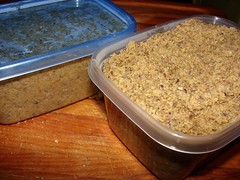
When the texture is soft and smooth and the scrapple is too thick to stir anymore, turn off the heat and spoon it into loaf pans or rectangular plastic containers to cool and set firm. Pack the scrapple tightly into the molds and knock the bottoms against the countertop to drive out air pockets. One recipe of scrapple usually makes several pounds, which can be more than you'll be able to eat before it goes bad, so using containers is a great idea - you can just snap lids on them and put them in the freezer for later.
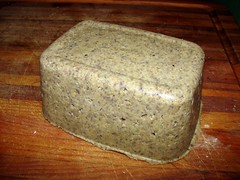
Chill the scrapple in the molds overnight. When they're cold, they're ready! Unmold one and cut it into 1/4-inch-thick slices. Fry the slices brown on both sides in lard, bacon fat, or butter and enjoy for breakfast as a side dish with eggs or all by itself. Some people like to put maple syrup on their scrapple (especially if not having it with eggs.) Or you can serve it accompanied by figs.

heard of scrapple before but I have to say that it sounds very tempting! All that porky goodness. mmmmm
ReplyDeleteI am beyond impressed! I've never seen this attempted at home! Very cool!
ReplyDeleteI'm a born and bread Pennsylvania boy. I was raised in the country/subs, and have a strong appreciation for my PA Dutchy heritage. I was raised on Meat n' Taters, and scrapple was a long standing staple for breakfast for me. The only store bought scrapple worth its weight is Hatfield, btw..still made in PA and fries up amazing. I am interested in making my own so this recipe was invaluable. I just hope more people try this dish instead of judging it. These days, more good meat than bad goes into scrapple. sorry to say for squimish-ers, organs are good meat. tons of iron and good proteins in the heart and liver. sub oatmeal as your binder and you get haggis-scrap, also a great boon to high colesteral. :)
ReplyDeleteI know this post of your scrapple is almost 10 years old but was so glad I came across it while searching on Google. I'm in the process of making it now and just took a taste before adding the cornmeal. Tastes fantastic.
ReplyDeleteIt's been a very easy process so far and will bookmark your page. I look forward to checking out your other recipes. Thanks- Dave
Thanks for the note. Although I'm not actively adding new pages to the blog right now, I've left it up because I still get lots of hits from people looking to try their hand at traditional recipes, which can sometimes be hard to find.
DeleteThank you so much. I got my bf to try it and loves it! I rather make it since going to roots farmers market isn't always possible.
ReplyDelete